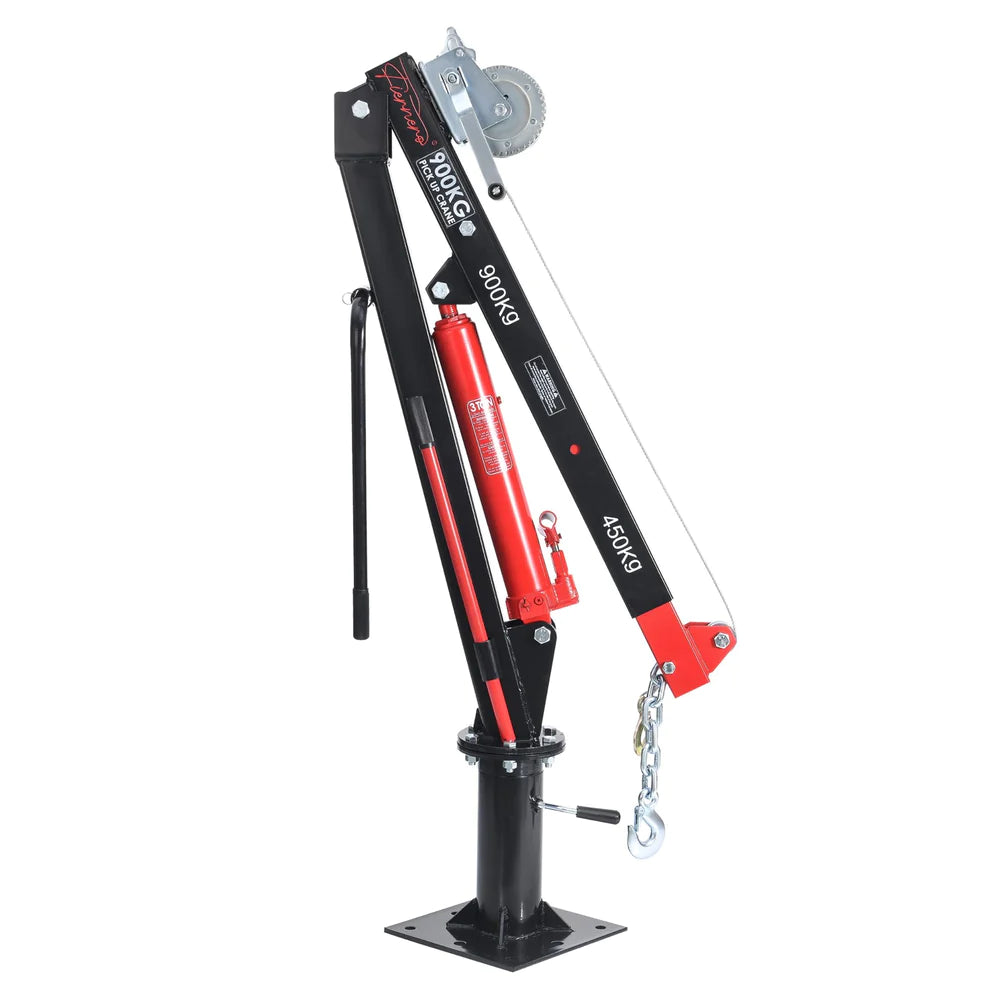Selecting the right engine crane is a pivotal decision in the automotive repair and maintenance arena. The correct crane not only enhances the efficiency of your projects but also ensures safety in your workspace.
This guide is dedicated to navigating the complexities of engine cranes, helping you pinpoint the perfect match for your automotive tasks. Choosing the right engine crane is about aligning your project requirements with the capabilities of the crane, ensuring your automotive projects run smoothly and safely.
Assessing Your Needs

Before diving into the vast selection of engine cranes, it’s imperative to first assess the specific requirements of your automotive projects. Understanding your needs will not only help narrow down your options but also ensure that the engine crane you choose enhances your work efficiency and safety. Here’s how to start:
Project Types
Consider the range of automotive projects you typically undertake or plan to tackle in the future. Are you working on light vehicles, heavy-duty trucks, or a mix? Different projects may require handling engines of varying weights and sizes, influencing the type of engine crane that's best suited to your needs.
Engine Weight and Size
The weight and dimensions of the engines you frequently deal with are perhaps the most critical factors in choosing an engine crane. Cranes come with specific weight capacities, and selecting one that can safely lift and maneuver the engines you work with is non-negotiable. Overloading a crane can lead to equipment failure, damage to the engine, or serious injury.
Frequency of Use
How often you'll use the engine crane also matters. For daily professional use, investing in a durable, high-capacity crane might be warranted. However, for occasional DIY projects, a more basic model could suffice.
Workspace Constraints
The size and layout of your workspace can significantly influence your choice of engine crane. Larger, fixed cranes require ample space for operation and storage, while foldable or mobile cranes might be better suited for smaller or multi-use spaces.
By carefully evaluating these aspects of your automotive projects and workspace, you can create a clear picture of what you need in an engine crane, making the selection process more straightforward and ensuring you invest in a tool that truly meets your requirements.
Understanding Engine Crane Types for Your Automotive Projects
Selecting the ideal engine crane for your automotive projects hinges on understanding the distinct types available and their specific features. Here’s a concise overview of the primary engine crane categories—hydraulic, electric, and foldable—alongside scenarios where each type particularly shines:
Hydraulic Engine Cranes

Features: Operated through a hydraulic mechanism that multiplies force, allowing for easy lifting of heavy loads. These cranes are noted for their sturdiness and durability.
Ideal Scenarios: Perfect for a broad spectrum of automotive work, from routine maintenance to complete rebuilds. They're especially suited for environments where the lifting capacity and reliability are paramount, such as in professional auto repair shops or for enthusiasts tackling major projects in home garages.
Electric Engine Cranes

Features: Utilize an electric motor to automate the lifting process, providing smooth and consistent power. They offer convenience and efficiency, significantly reducing manual labor.
Ideal Scenarios: Best for high-volume automotive workshops where speed and ease of use are critical. Electric cranes excel in situations requiring frequent engine lifts, providing a quick and effortless lifting solution that can streamline workflow and increase productivity.
Foldable Engine Cranes

Features: Designed with space-saving in mind, these cranes can be easily folded and stored away when not in use. Despite their compact design, they still offer ample lifting power for most tasks.
Ideal Scenarios: Ideal for hobbyists or small shops with limited space. Foldable cranes are a great choice when the workspace needs to be cleared for other tasks or when the crane is used intermittently. They offer the perfect balance between functionality and convenience for occasional engine lifts or when floor space is at a premium.
By matching the engine crane type to your specific automotive project needs, workspace constraints, and the engines you frequently work with, you can ensure a seamless and efficient operation. Whether you require the rugged power of a hydraulic crane, the streamlined operation of an electric model, or the compact convenience of a foldable crane, there’s an engine crane tailored to support your automotive endeavors effectively.
Key Features to Consider When Choosing an Engine Crane
Selecting the right engine crane extends beyond the basic type; it's about understanding the key features that will meet the demands of your automotive projects. Here's what to look for:
Lifting Capacity
Lifting capacity is perhaps the most critical factor to consider. It determines the weight your crane can safely handle, directly impacting its utility across various engine types and sizes.
- Why It’s Crucial: Matching the crane’s lifting capacity with the engines you commonly work with ensures safe, efficient lifts without overburdening the equipment.
- Matching with Engines: Assess the weight range of the engines you plan to lift. Opt for a crane with a capacity that exceeds your heaviest engine to accommodate future needs and provide a safety margin.
Height Range
The versatility of an engine crane is significantly enhanced by its adjustable height, enabling you to lift engines out of different vehicle types and work within varied garage setups.
- Importance: Adjustable height ensures that the crane can navigate over vehicle hoods or undercarriages and fit into your working space, whether it’s lifting from a low sports car or a high SUV.
- Workspace Adaptability: Consider the height constraints of your workspace, including ceiling height or any overhead storage, to ensure the crane can operate effectively within those limits.
Mobility and Space
The ease of moving your engine crane around the workspace and the space it occupies when not in use are important considerations for maintaining a functional work environment.
- Crane Mobility: Look for high-quality wheels that can withstand the weight and frequent movement, ensuring ease of positioning and maneuverability within your workspace.
- Workspace Requirements: Factor in the physical footprint of the crane, especially if space is limited. Foldable models can be a smart choice for maximizing workspace utility.
Durability and Reliability
The construction quality of your engine crane influences its longevity and the safety of its operation. Investing in a durable and reliable crane pays off in the long run.
- Identifying Quality: Check the materials used (preferably heavy-duty steel) and the construction details, such as welding quality and the robustness of moving parts.
- Design Considerations: A well-designed crane not only stands up to the rigors of regular use but also features safety mechanisms like overload protection to prevent accidents.
By carefully evaluating these key features—lifting capacity, height range, mobility and space, along with durability and reliability—you can choose an engine crane that not only suits your immediate needs but also serves as a long-term asset in your automotive repair and maintenance toolkit.
Additional Considerations in Choosing the Right Engine Crane

When selecting an engine crane for your automotive projects, beyond the key features like lifting capacity and mobility, there are other crucial factors to consider. These additional considerations ensure you not only pick a crane that fits your immediate needs but also one that offers long-term value and safety.
Budget
Balancing the cost with the quality and capabilities of an engine crane is essential. Higher-priced models often come with advanced features and greater durability, but it's important to assess whether these attributes justify the expense based on your specific usage requirements. Consider the crane's cost as an investment in your automotive projects' efficiency and safety, aiming for the best value rather than just the lowest price. Look for cranes that offer the best combination of the features you need within your budget.
Safety Features
Engine crane safety features are non-negotiable when it comes to protecting yourself and your workspace. Key safety elements to look for include overload protection, which prevents the crane from lifting beyond its capacity, and a stable base design to ensure the crane remains steady under load. Additional safety mechanisms, like safety valves to prevent sudden drops and locking casters on wheels for secure positioning, further enhance operational safety. Selecting a crane with comprehensive safety features minimizes risks and underscores a commitment to a secure work environment.
Ease of Use
The efficiency of your projects can significantly benefit from an engine crane that’s designed with the user in mind. Features that contribute to ease of use include smooth hydraulic operation for hydraulic cranes, ensuring consistent and manageable lifting. For electric models, clear control interfaces allow for straightforward operation.
Additionally, cranes with adjustable boom lengths or heights offer versatility across various projects, making it easier to achieve the perfect lift every time. Consider how user-friendly features can reduce workload and improve the precision of your engine handling tasks.
In selecting the right engine crane, taking into account your budgetary constraints, the necessity of safety features, and the value of ease of use, alongside the crane's primary capabilities, ensures a well-rounded decision-making process. By weighing these factors carefully, you can choose an engine crane that not only meets your current automotive project needs but also stands as a reliable tool in your workshop for years to come.
Making the Decision: Navigating Your Engine Crane Purchase
The journey to acquiring the right engine crane for your automotive projects culminates in making a well-informed decision. This critical phase involves delving into research, understanding the nuances of product quality through reviews, and selecting a vendor known for reliability and exceptional customer support. Here’s how to confidently navigate your way to a smart engine crane investment:
Research and Reviews
- Leverage User Feedback: Start by exploring reviews and feedback from users who have hands-on experience with the engine cranes you're considering. Their insights can reveal real-world performance, durability, and any potential issues not apparent in product descriptions.
- Product Comparisons: Utilize online forums, automotive blogs, and comparison websites to gather comprehensive information on different engine cranes. Look for side-by-side comparisons that highlight strengths and weaknesses based on actual usage.
Vendor Reputation and Support
- Reputable Suppliers: Opt for vendors with a proven track record in the automotive equipment industry. A vendor's reputation can often be gauged through online reviews, ratings, and the overall presence in the market.
- Customer Support: Ensure that the vendor offers robust customer support. This includes pre-sale consultations to help you choose the right model, as well as post-sale support for any queries or issues that may arise. Availability of spare parts and service options are also critical considerations.
- Warranty and Service Agreements: Look for products that come with a comprehensive warranty and clear service agreements. Understanding the warranty's scope and the process for claiming it can save you from future headaches.
Choosing the perfect engine crane is a crucial step in enhancing your automotive maintenance and repair projects. By carefully assessing your needs, understanding the different types of engine cranes available, and considering key features such as lifting capacity, height range, mobility, and durability, you can make an informed decision that best suits your workshop's demands. Additional considerations like budget, safety features, and ease of use play significant roles in ensuring you get the most value and functionality out of your investment.These actions ensure that your engine crane not only meets your immediate needs but also stands as a reliable resource in your automotive toolkit over the years.
As you move forward in selecting your engine crane, remember that this tool is more than just a piece of equipment—it's a key player in the safety, efficiency, and success of your automotive projects. For more insights into choosing and using engine cranes, and to explore a wide range of high-quality engine cranes designed to meet various automotive needs, don’t hesitate to visit our comprehensive guide and product listings. Your next automotive project deserves the support of the best tools in the industry, and we're here to help you find them.

